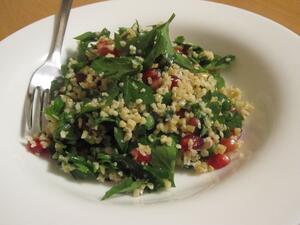Eating Jewish: Recipes for a tasty Tu B’Shevat table
Although there are no specific dishes that have traditionally been prepared for Tu B’Shevat, the custom of serving dishes that contain fruits and nuts has emerged. There is also the custom of consuming the Shevah Minim or "Seven Species," the five fruits and two grains found in the land of Israel. According to Gil Marks in the Encyclopedia of Jewish Food, the seven species are either eaten in the order in which they’re mentioned in Deuteronomy, namely wheat, barley, grapes, figs, pomegranates, olives and dates or in order of their importance in ancient Israel, wheat, barley, olives or olive oil, dates, grapes or wine, figs and pomegranates. Some people also eat fruits, such as apples, quinces, walnuts, pistachios and carob, which are mentioned in the Bible or have come to be associated with Israel.
With the various ingredients that one can choose to include on their table for Tu B’Shevat, there is room for much creativity and the possibilities are endless. It was difficult to decide what I wanted to share with you on here, when there were so many recipes I wanted to make. Yet, I decided on the two following recipes because not only do they provide a delectable showcase for the ingredients customarily eaten on this holiday, but they are also simple and quick to prepare.
The salad I made for Tu B’Shevat is a different take on the classic taboulleh salad, with the addition of pomegranate seeds, a recipe that Joan Nathan ate at a restaurant in Jerusalem. I sometimes find that taboulleh lacks the crunchiness that can be so satisfying when eating a salad, and the pomegranate seeds provide this along with sweetness that is a perfect match for the strong flavor of the parsley in this dish. Furthermore, the vibrant green of the parsley and the deep red of the pomegranate seeds scattered throughout this salad jump right off the plate and in my opinion make this salad all the more irresistible. The desert I chose is a date and walnut pie that emerges from the oven a lovely dark brown with a taste and texture that is reminiscent of pecan pie, but without its intense sweetness. What you get is a desert that is dense and chewy, in which the caramel flavor of the dates becomes more intense after having been baked, while the chopped walnuts provide a crunchy contrast against the soft dates.
I hope that these recipes will provide a welcome addition to your own Tu B’Shevat table, and I would love to hear about some of your own Tu B’Shevat food traditions or about the recipes you decided to prepare this year.
Pomegranate Taboulleh
From Joan Nathan’s The Foods of Israel Today
1 cup medium (#2) bulgur
2 cups chopped flat-leafed Italian parsley, including a few stems
1 cup pomegranate seeds
1 small clove galic, crushed or grated on a microplane
Juice of 1 lemon, or to taste
Salt and freshly ground pepper to taste
3 tablespoons extra virgin olive oil
-
Soak the bulgur in water to cover for at least 1 hour. Drain and squeeze out the excess water. Put the bulgur in a serving bowl.
-
Add the parsley and pomegranate seeds.
-
Put the garlic, lemon juice, salt and pepper in a separate small bowl. Whisk in the olive oil. Pour over the bulgur and toss gently with your hands. Allow to marinate, refrigerated for several hours.
Date and Walnut Pie
From Saveur
The top of this pie browns quite quickly, so I would advise covering the surface with a piece of aluminum foil once it becomes a dark golden brown. Just make sure to tent your piece of aluminum foil so it doesn’t touch the surface of the pie, which is delicate while baking.
4 tablespoons flour
1 cup sugar
2 teaspoon baking powder
1 cup pitted chopped dates
1 cup walnuts, chopped
2 eggs
-
Preheat oven to 350 degrees. Grease and flour a 9-inch glass or metal pie dish. Combine sugar, baking powder, and 3 tablespoons of the flour in a medium bowl and set aside. Put the dates and 1 tablespoon flour into another medium bowl and stir with a fork until dates are evenly coated with flour. Add walnuts, mix well and set aside.
-
Put eggs into a medium mixing bowl and beat well. Stir in date and walnut mixture. Add flour and sugar mixture, and stir until well combined. Pour batter into prepared dish and bake until a toothpick inserted into the center comes out clean, about 30-35 minutes. Serve warm or at room temperature.









My local grocery store happened to have pomegranates for sale just over a week ago, but they're not selling them anymore. If you can't find pomegranates, I think dried cranberries or cherries would also be good in this salad.
Where did you find pomegranates for your salad? I also had a similar salad planned for our 1st Tu B'Shevat dinner, but could not find pomegranates anywhere!